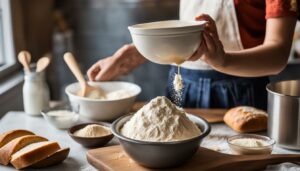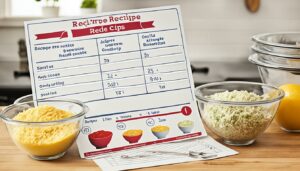Originally posted on December 13, 2023 @ 9:21 pm
Are you wondering if you can double a bread recipe? Do you want to know how to double a bread recipe without compromising the delicious flavor and texture of your loaves? Look no further! In this guide, we will walk you through the process of doubling a bread recipe, providing you with all the tips and tricks you need to create larger batches of dough with ease.
Whether you’re baking for a crowd or looking to stock up on freshly baked bread for the week, doubling a bread recipe can be a game-changer. With the right techniques and adjustments, you can save time and effort while still achieving the same exceptional results.
Let’s dive in and discover how you can double a bread recipe like a pro!
Contents
- 1 Adjusting Ingredient Quantities with the Baker’s Formula
- 2 Benefits of Doubling a Bread Recipe
- 3 Key Considerations for Doubling a Bread Recipe
- 4 Assessing Dough Readiness for Proofing and Baking
- 5 Importance of Timing and Conditions for Proofing Dough
- 6 Alternative Approaches to Doubling a Bread Recipe
- 7 Benefits of the Mass Effect in larger Batches of Dough
- 8 Conclusion
- 9 FAQ
- 9.1 Can you double a bread recipe?
- 9.2 How do I double a bread recipe?
- 9.3 What are the benefits of doubling a bread recipe?
- 9.4 What should I consider when doubling a bread recipe?
- 9.5 How can I assess when dough is ready for proofing and baking?
- 9.6 Why is timing and conditions important for proofing dough?
- 9.7 Are there alternative approaches to doubling a bread recipe?
- 9.8 What are the benefits of the Mass Effect in larger batches of dough?
- 9.9 Any concluding thoughts on doubling a bread recipe?
- 10 Source Links
Key Takeaways:
- Doubling a bread recipe is a time-saving and cost-effective strategy for bakers.
- Adjusting ingredient quantities using a baker’s formula is crucial for consistency.
- Doubling a recipe offers benefits such as saving time, effort, and money.
- Considerations for adjusting yeast quantity, fermentation time, and mixing time are important.
- Assessing dough readiness through visual cues and the poke test is essential.
Adjusting Ingredient Quantities with the Baker’s Formula

The baker’s formula is an invaluable tool for bakers when it comes to adjusting ingredient quantities for a bread recipe, especially when doubling the recipe. By utilizing this formula, bakers can ensure consistency in their dough by calculating the percentages of each ingredient based on the total weight of flour.
“The baker’s formula allows bakers to accurately scale their recipes while maintaining the same ratios of ingredients.”
Let’s consider an example: suppose the original bread recipe calls for 480g of white flour and 50g of wholemeal flour, with a total dough weight of 903g. By applying the baker’s formula, bakers can calculate the new quantities for each ingredient by multiplying the total weight of flour by the respective percentage. This method guarantees precise scaling of the recipe while preserving the desired ratios of ingredients.
| Ingredient | Original Quantity | Percentage | New Quantity (Doubled Recipe) |
|---|---|---|---|
| White Flour | 480g | 53% | 960g |
| Wholemeal Flour | 50g | 5.5% | 100g |
| Total Flour | 530g | 58.5% | 1060g |
| Other Ingredients | 373g | 41.5% | 746g |
| Total Dough Weight | 903g | 100% | 1806g |
Bakers can simply use this formula to adjust the ingredient quantities for any bread recipe they wish to double. It provides a reliable method for maintaining the integrity of the original recipe while efficiently scaling the batch size.
Benefits of Doubling a Bread Recipe
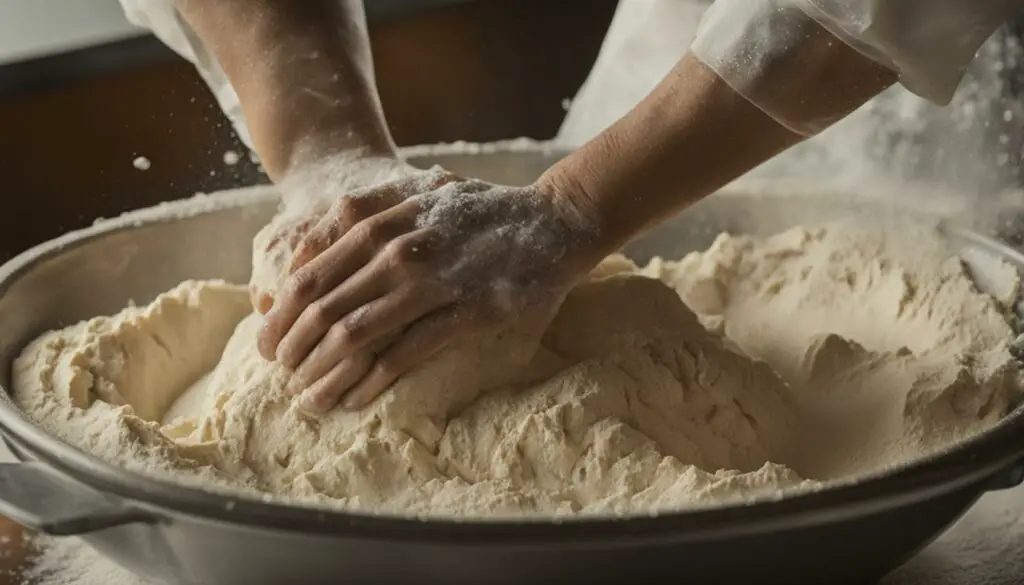
Doubling a bread recipe provides numerous benefits for bakers, including saving time and effort in the bread baking process. By increasing the batch size, bakers can make larger quantities of dough without having to spend additional time on preparation and mixing. This is especially advantageous for bakers who frequently create multiple varieties of bread using a common base dough. Instead of making separate batches for each bread type, doubling the recipe allows for efficiency and streamlined production.
In addition to time savings, doubling a bread recipe can also lead to cost savings. By making a larger batch, bakers can significantly reduce the need for multiple batches or additional ingredients. This can result in potential savings in terms of both time and money. Less time is spent on repetitive tasks, and fewer ingredients need to be purchased, contributing to a more efficient and economical baking process.
However, it’s important to be mindful that doubling a recipe may result in all the bread tasting the same, as each loaf follows the same proportions and ingredients. To avoid monotony and add variety to the bread, bakers can employ specific techniques to manipulate each bread type and make them unique. This can include adding different mix-ins, toppings, or fillings to create distinct flavors and textures.
Overall, doubling a bread recipe offers bakers the convenience of time and effort savings, as well as the potential for cost savings. It allows for larger batches of dough to be made without compromising on flavor or texture. By utilizing inventive techniques, bakers can keep their bread offerings diverse and appealing to their customers or enjoying a delightful array of bread options at home.
Key Considerations for Doubling a Bread Recipe
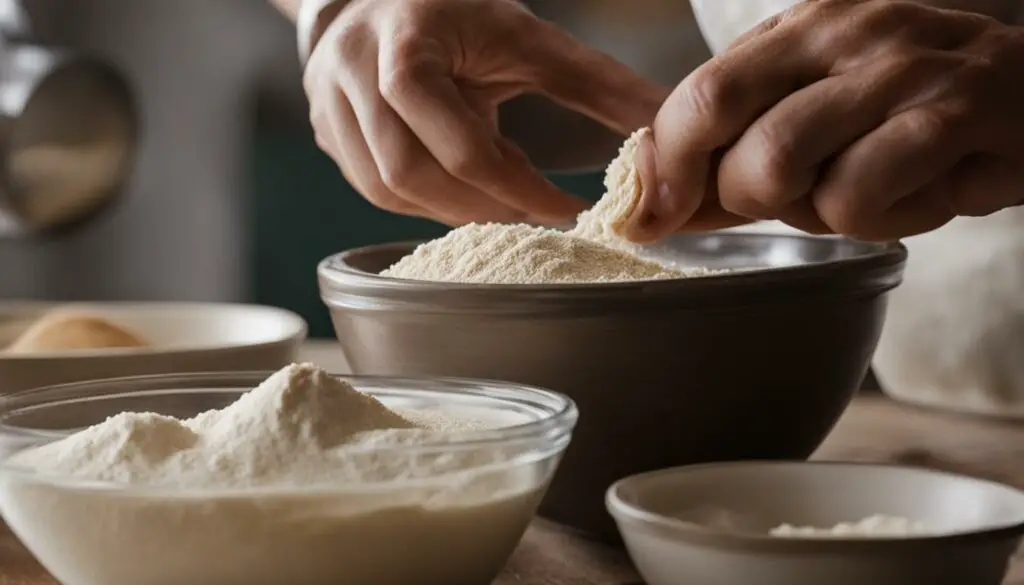
When doubling a bread recipe, bakers should consider several key factors to achieve the best results. Here are some important considerations to keep in mind:
Adjusting Yeast Quantity
When scaling up a bread recipe, it is recommended to slightly reduce the quantity of yeast, typically by around 10%. This adjustment helps account for the increased batch size and ensures proper fermentation. However, it’s important to take other variables into consideration, such as the temperature and freshness of the yeast. These factors can also affect the overall rise and flavor of the bread.
Adjusting Fermentation Time
Doubling a bread recipe may require adjusting fermentation time, as larger batches of dough may ferment faster compared to smaller ones. To prevent over-proofing and achieve the desired texture and flavor, it is advisable to opt for shorter rise times. Regularly checking the dough’s readiness through visual cues and the poke test can help determine the appropriate fermentation time.
Adjusting Dough Mixing Time
When doubling a recipe, especially for bakers using less powerful stand mixers, it’s essential to consider the mixing time. Larger batches of dough may require a longer mixing time to properly develop gluten and ensure uniform incorporation of ingredients. Bakers should be aware of the limitations of their equipment and adjust the mixing time accordingly to achieve the desired dough texture.
In summary, doubling a bread recipe requires careful consideration of yeast quantity, fermentation time, and dough mixing time. By making these necessary adjustments, bakers can successfully scale their recipes and enjoy consistent results. The table below summarizes the key considerations for doubling a bread recipe:
| Consideration | Action |
|---|---|
| Yeast Quantity | Slightly reduce yeast by around 10% |
| Fermentation Time | Adjust rise times for larger batches |
| Dough Mixing Time | Extend mixing time for larger batches or less powerful mixers |
By considering these factors, bakers can confidently double their bread recipes and achieve delicious, consistent loaves every time.
Assessing Dough Readiness for Proofing and Baking
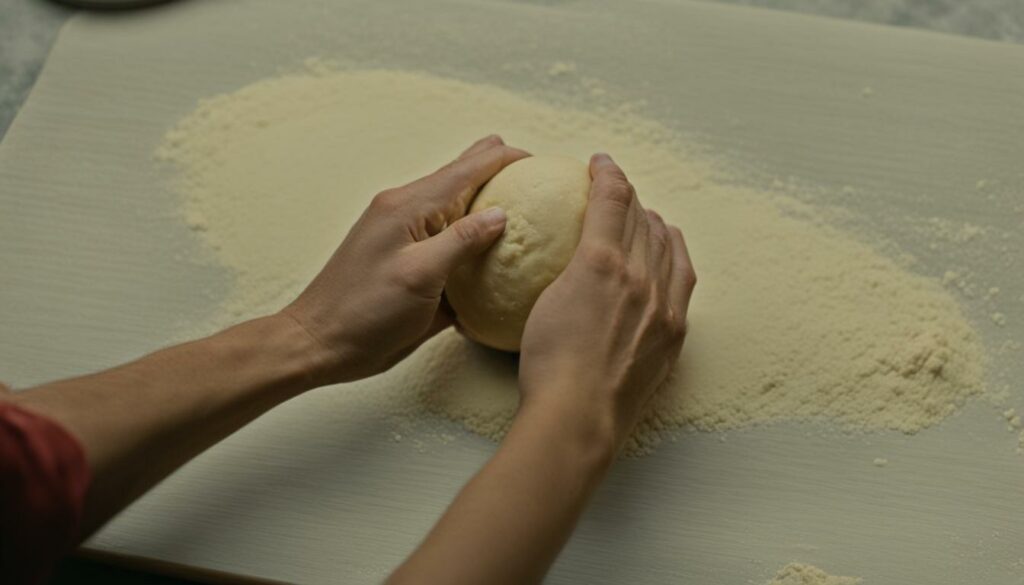
Determining when dough is ready for proofing and baking is crucial for achieving successful loaves of bread. Visual cues can help bakers gauge the readiness of their dough. During the first rise, the doubled volume is a reliable indicator that the dough is ready for the next step. For the second rise, whether using a pan or shaping free-form breads, the dough should reach about 1 inch over the lip of the pan as a visual cue that it has proofed sufficiently.
But what about free-form breads? That’s where the poke test comes in handy. With a floured finger, gently press the dough. If the indentation remains and doesn’t bounce back, it’s a sign that the dough is ready for baking. However, if the dough pops back out, it needs more time to proof.
| Visual cues for assessing dough readiness: |
|---|
| Doubled volume during the first rise |
| The dough reaching 1 inch over the lip of the pan during the second rise |
For free-form breads:
- Gently press the dough with a floured finger
- If the indentation remains, the dough is ready for baking
- If the dough pops back out, it needs more time to proof
Visual cues for assessing dough readiness:
- Doubled volume during the first rise
- The dough reaching 1 inch over the lip of the pan during the second rise
Importance of Timing and Conditions for Proofing Dough

When it comes to proofing dough, timing and conditions play a crucial role in achieving the perfect rise and texture. The specific rise times provided in a recipe serve as general guidelines, but it’s important to understand that several factors can influence the speed of dough rising.
One of the key factors is temperature. Higher temperatures can accelerate fermentation, leading to a quicker rise, while colder temperatures may require longer proofing times. Similarly, humidity levels can impact dough rise. Higher humidity can create a more favorable environment for yeast activity, promoting faster fermentation.
Another factor to consider is the size and shape of the dough. In a larger batch of dough, the mass effect comes into play, where the increased quantity of dough allows for enhanced fermentation. This can result in a superior flavor and texture of the bread.
The vessel used for proofing also affects timing and conditions. A shallow dish may lead to faster rising due to increased exposure to warm air, while a deep dish or covered container may slow down the rise by trapping heat and moisture.
Lastly, shaping technique plays a role in proofing. Some breads, like baguettes, require a longer proofing time to develop their characteristic shape and texture before baking.
It’s crucial for bakers to be aware of their kitchen conditions and adjust their expectations accordingly. Regularly testing the dough’s readiness using visual cues and the poke test can help determine if the dough is underproofed or overproofed.
“The specific rise times provided in a recipe serve as general guidelines, but it’s important to understand that several factors can influence the speed of dough rising.”
Alternative Approaches to Doubling a Bread Recipe
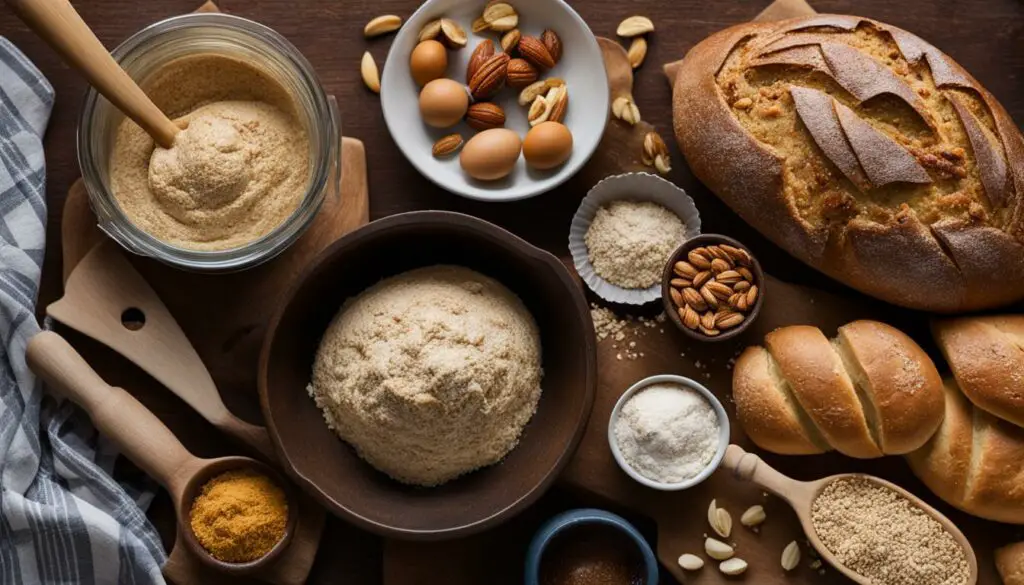
While doubling a bread recipe is a common practice, it may not always be the most practical option for bakers. Fortunately, there are alternative approaches you can consider to achieve larger batch sizes without compromising on quality. Here are two popular methods:
1. Using the Dough Cycle on a Bread Machine
If you own a bread machine, utilizing the dough cycle can be a convenient way to handle larger batches. Simply follow your recipe, doubling the ingredients, and let the machine do the initial mixing and kneading. Once the dough cycle is complete, transfer the dough to a baking tin and continue with the remaining steps, such as shaping and proofing. This method allows you to enjoy the benefits of doubling a recipe while avoiding the strain on your bread machine.
2. Dividing the Dough into Batches
Another option is to divide the dough into individual batches after the bulk fermentation stage. Once the dough has risen, gently divide it into equal portions. Shape and proof each batch separately, using separate containers or pans. This method is particularly useful if you’re working with limited proofing space or if you want to experiment with different proofing conditions. Not only does this approach make managing larger quantities more manageable, but it also allows for greater flexibility in your bread baking process.
Alternatively, you can make a single recipe the night before and refrigerate the dough. The next day, simply shape and proof the dough as needed. This method optimizes freshness and convenience by allowing you to bake bread when it’s most convenient for you.
By exploring these alternative approaches, you can successfully create larger batches of bread without the need for doubling the recipe. Whether you choose to use the dough cycle on a bread machine or divide the dough into separate batches, these methods offer flexibility and convenience while ensuring delicious results. So go ahead and give them a try!
Benefits of the Mass Effect in larger Batches of Dough
Larger batches of dough have the advantage of the “Mass Effect,” which refers to the increased variety of minerals and bacteria present in the dough. This leads to an enhanced rate of fermentation and the development of a superior flavor and maturity in the bread.
Bakers can take advantage of this effect when working with larger batch sizes, adjusting fermentation times or reducing the quantity of levain to compensate. By understanding the benefits of the Mass Effect, bakers can optimize their recipes and achieve exceptional results.
Conclusion
Scaling up a bread recipe can be a game-changer for bakers seeking larger batch sizes and more efficient baking. By utilizing a baker’s formula to adjust ingredient quantities and considering crucial factors such as yeast quantity, fermentation time, and equipment limitations, bakers can successfully double their bread recipes without compromising on flavor or texture.
Mastering the art of gauging dough readiness is essential for consistent results. By relying on visual cues, like the doubling volume during the first rise and the dough height reaching 1 inch over the pan’s lip for the second rise, bakers can ensure perfectly proofed dough. The poke test, an ingenious technique, allows bakers to assess dough readiness by gently pressing on the dough’s surface to determine its elasticity and responsiveness.
While doubling a bread recipe is the go-to method for larger batches, bakers can also explore alternative approaches. Opting for the dough cycle on a bread machine followed by baking in the oven is one such technique, allowing for manageable batch sizes and maximum convenience. Similarly, dividing the dough into individual batches after bulk fermentation provides more control over proofing conditions and customization.
Finally, bakers can tap into the Mass Effect with larger batches, reaping the benefits of intensified fermentation and superior flavor development. Adjusting fermentation times and yeast quantities enables bakers to optimize their recipes and create exceptional loaves of bread.
With careful attention to detail, adherence to scaling techniques, and an understanding of dough readiness, bakers can confidently embark on doubling their bread recipes, unlocking a world of possibilities and enjoying delicious results every time.
FAQ
Can you double a bread recipe?
Yes, doubling a bread recipe is possible and can be a time-saving and cost-effective strategy for bakers.
How do I double a bread recipe?
To double a bread recipe, adjust the quantities of each ingredient using a baker’s formula, which calculates the percentages based on the total weight of flour in the recipe.
What are the benefits of doubling a bread recipe?
Doubling a bread recipe saves time and effort by allowing for larger batches of dough, and it can also save money by reducing the need for multiple batches or ingredients.
What should I consider when doubling a bread recipe?
When doubling a bread recipe, consider adjusting the quantity of yeast, fermentation time, and mixing time. Be aware of the limitations of your equipment and adjust batch sizes accordingly.
How can I assess when dough is ready for proofing and baking?
Visual cues, such as doubled volume or dough reaching 1 inch over the lip of the pan, can help gauge dough readiness. The poke test, where an indentation remains in the dough, is also useful.
Why is timing and conditions important for proofing dough?
Various factors such as temperature, humidity, dough size, and shaping technique can affect the speed of dough rising. Understanding your kitchen conditions is crucial to prevent underproofing or overproofing.
Are there alternative approaches to doubling a bread recipe?
Yes, alternative approaches include using the dough cycle on a bread machine and then baking the dough in the oven, or dividing the dough into individual batches after bulk fermentation.
What are the benefits of the Mass Effect in larger batches of dough?
The Mass Effect refers to the increased variety of minerals and bacteria present in larger batches of dough, leading to enhanced fermentation, flavor, and maturity in the bread.
Any concluding thoughts on doubling a bread recipe?
Doubling a bread recipe can be a valuable technique for bakers, and by following a baker’s formula, considering key factors, and understanding dough readiness, bakers can successfully scale their recipes for delicious results each time.


